Across Ontario, there are many surviving enclaves of the 19th century. In the middle of that century, much of the Province saw a massive upswing in population growth. But none can compare to one of the oldest urban centres in Ontario, that of Niagara-On-The-Lake. And Heather and I took a short getaway here last week after discovering the lovely Pillar & Post Inn the previous year.
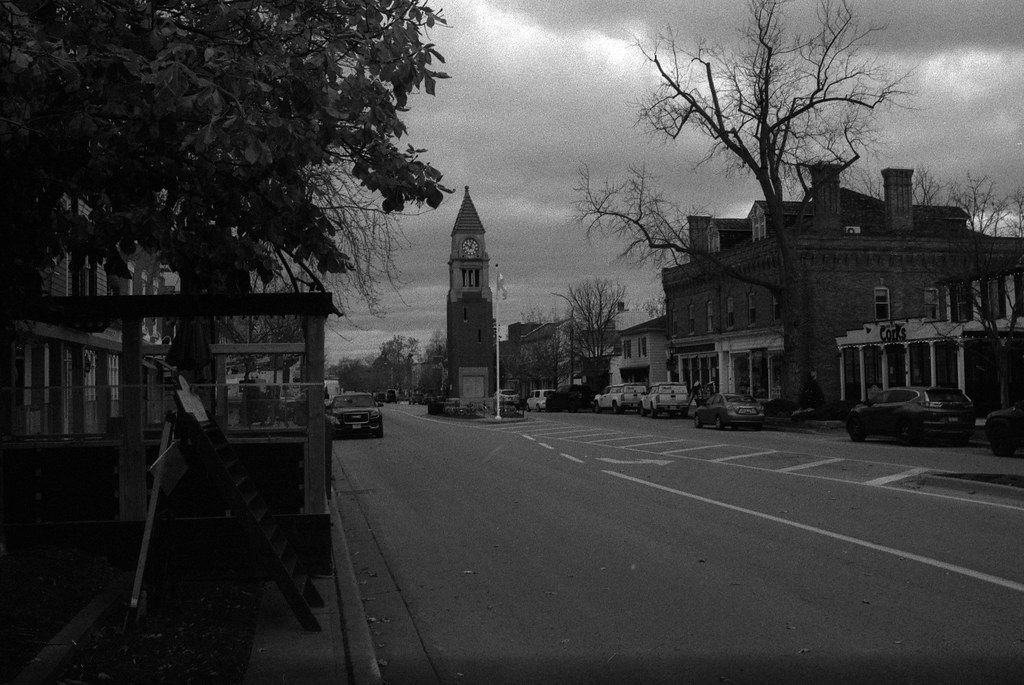
Nikon FM – AI-S Nikkor 35mm 1:2.8 (Yellow-12) – Fomapan 400 @ ASA-400 – Flic Film Black/White & Green (1+49) 13:30 @ 20C
The small peninsula that sits at the mouth of the Niagara River first saw human settlement back in 100 CE by an off-shoot of a people known as the Mound Builders. Little is known of these people in Canada; the first noted Indigenous peoples were those of the Neutral Nation who settled off Mississauga Point in 1400 CE. These made contact with French fur traders in 1615 when the French established their presence across the Niagara River at what is today Fort Niagara. The Neutrals were decimated by sickness and war when the Seneca and Iroquois swept north during the Beaver Wars, while the Seneca stayed to the south of the River, the Iroquois settled to the north. These were forced off the land, and in the 1700s, the Mississaugas arrived. The area became the first major land purchase by the British Crown from the Mississaugas in 1781. Known as Treaty 381 or the Niagara Purchase, the goal was to secure land for an overflow of United Empire Loyalists fleeing to Loyalist strongholds during the American Revolutionary War. Fort Niagara became one of these enclaves, and needing more space, Colonel John Butler led a group north of the Fort and surveyed a small military settlement.
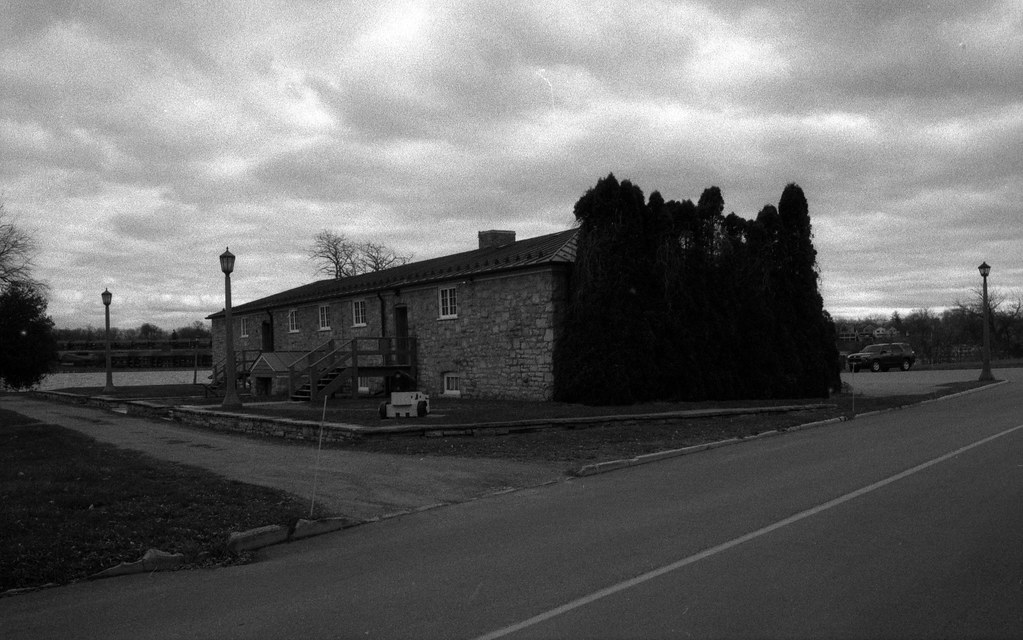
Nikon FM – AI-S Nikkor 35mm 1:2.8 (Yellow-12) – Fomapan 400 @ ASA-400 – Flic Film Black/White & Green (1+49) 13:30 @ 20C
The Royal Navy’s Barracks had been located here since 1765 and remained separate from the small settlement known as Butlersburg. Although that name quickly fell out of favour for West Niagara. Being one of the only built-up centres, in 1792, Lieutenant-Governor John Graves Simcoe renamed the town Newark and established the capital of Upper Canada, holding the first Parliament under an oak tree according to local legend. The community quickly grew, and grand manor homes were constructed by the members of Parliament. It also became a port of entry for many American slaves who sought out Upper Canada after the Bill to Reduce Slavery passed through the Provincial Parliament.

Nikon FM – AI-S Nikkor 35mm 1:2.8 (Yellow-12) – Fomapan 400 @ ASA-400 – Flic Film Black/White & Green (1+49) 13:30 @ 20C
In 1796, Simcoe moved the seat of Government to York, as the Jay Treaty saw the threat of renewed violence between England and the United States. The British garrison was also forced to relocate from Fort Niagara to Fort George. Despite the loss of status, the town became a bustling port of commerce, and in 1804 the first lighthouse on the Great Lakes sent out a beacon from Mississauga Point. But when the Anglo-American War of 1812 opened, it turned into a battlefield. American troops landed at the end of May 1813 and after an intense battle, the British garrison at Fort George abandoned the region, leaving it under American occupation for the balance of the year. In December, Joseph Wilcocks, who led a group of turncoat Canadians known as the Canadian Volunteers, presented the idea to the garrison commander to destroy the community in the face of a British army marching on the tiny enclave. The American commander reluctantly allowed the action, and the Canadian Volunteers and a handful of American militia troops set fire to most of the town’s buildings. Undaunted the community rebuilt after the war, many buildings took shape from the rubble of the destroyed ones.
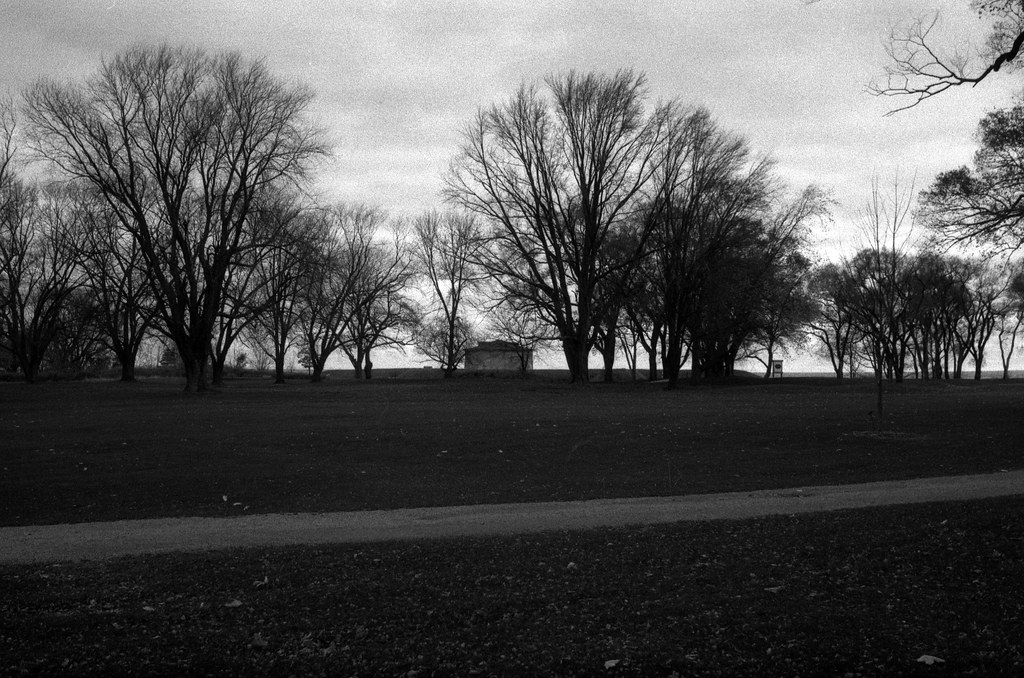
Nikon FM – AI-S Nikkor 35mm 1:2.8 (Yellow-12) – Fomapan 400 @ ASA-400 – Flic Film Black/White & Green (1+49) 13:30 @ 20C
By the 1820s, the community had almost completely rebuilt, returning as a commercial hub. Focused mainly around agriculture (mostly fruit), shipping, and shipbuilding. Sadly much of the shipping industry would leave after the opening of the Welland Canal. Thankfully the agriculture business continued to boom through the region thanks to the mild climate and excellent soil. The opening of the Welland Canal and its proximity allowed the product to move quickly to a broader market. The railroad’s arrival in the 1850s helped bring more people to the region; access to the lake, those mild temperatures, beautiful farms, and public golf courses helped drive people out from the city to take vacation time. It also helped people make their home in the region; the first public school opened in 1859 and a high school in 1875. To help differentiate themselves from Niagara Falls, Niagara-On-The-Lake was adopted in 1880. At the same time, the community rode high through the remainder of the 19th and into the 20th centuries, after the First World War. The Great Depression hit the community hard in both the Agriculture and Tourism sectors, further harm when passenger rail service was cut to the community. Some assistance came in 1930 when the reconstruction of Fort George and Fort Mississauga and further recognition of the battlefields of the Anglo-American War of 1812 along the Niagara River. But the fortunes were even more devastated after the Second World War, and the military pulled out of the community. However, the poor economic fortunes allowed the community to maintain some of its historic buildings and homes as they could not afford the urban renewal sweeping across Ontario in the mid-century. While we can look back now and see this as a good thing, at the time, I’m sure many were not too happy with the state of things. This all changed in 1962 with the opening of the Shaw Festival, celebrating the works of George Bernard Shaw. The old 1847 courthouse became the first playhouse, and soon money and income returned. Gentrification swept the community by finding an enclave of nearly new post-1812 architecture and a new form of renewal as wealth poured in, a return to agriculture with the opening of the Niagara Wine Region with the Inniskillin Winery which opened in 1970. Today, Niagara-On-The-Lake is a bustling tourist town with high-end shops, bed-and-breakfasts, and many boutique hotels. Making it a great spot for a day trip or a weekend away.
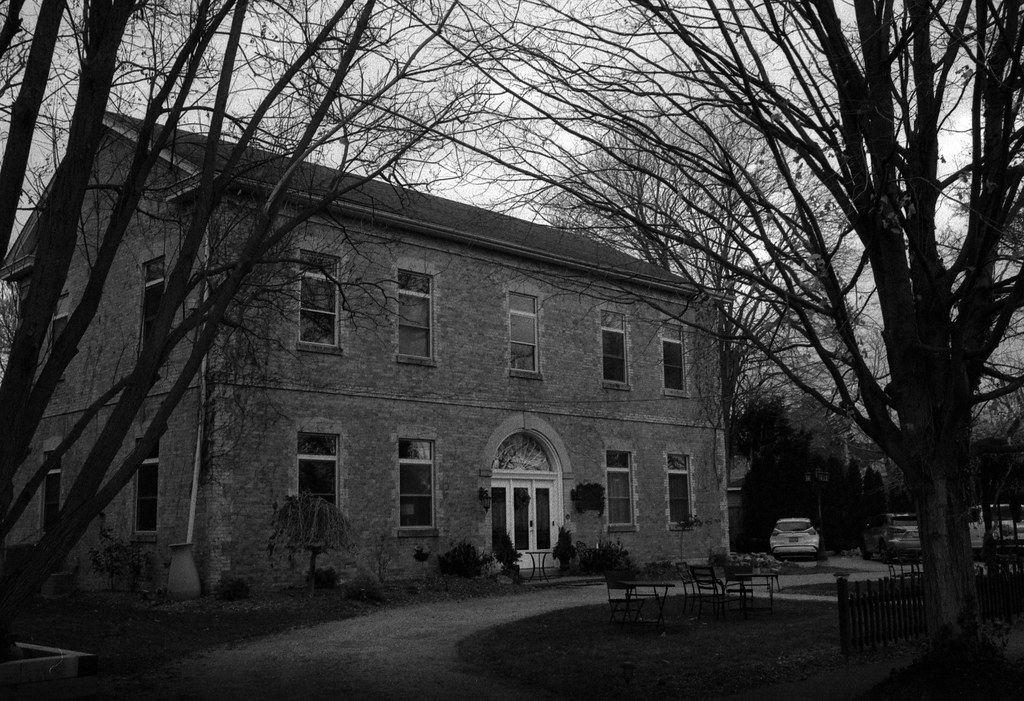
Nikon FM – AI-S Nikkor 35mm 1:2.8 (Yellow-12) – Fomapan 400 @ ASA-400 – Flic Film Black/White & Green (1+49) 13:30 @ 20C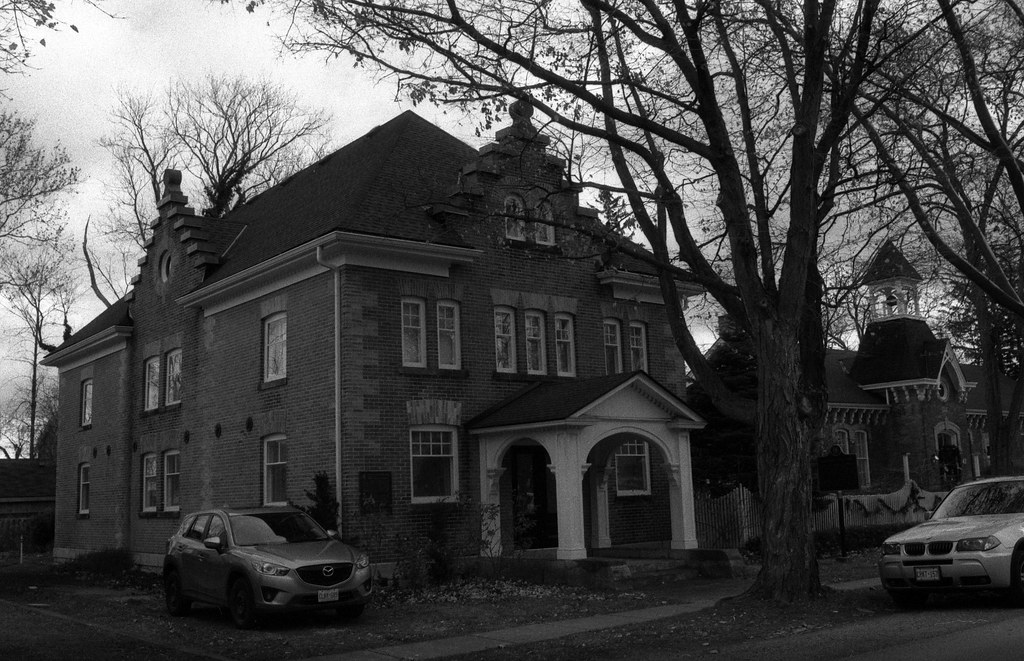
Nikon FM – AI-S Nikkor 35mm 1:2.8 (Yellow-12) – Fomapan 400 @ ASA-400 – Flic Film Black/White & Green (1+49) 13:30 @ 20C
Okay, so I love to cheat when it comes to image selection, especially when you have so many unique subjects to choose from. Instead of my usual seven, I included ten photos this week. Like any post about an urban location, the featured image is of the main street but looking from a different direction than what I usually photograph, featuring the unique World War One memorial, which I’ve only found in Niagara-On-The-Lake and equally iconic. From there, I went with buildings and items that had interesting stories and were unique to the community. While it would be easy to include everything from the War of 1812, that was not the week’s theme. Through the history section, I had some of the bonus images, including Navy Hall, a memorial to the Simcoes and Fort Mississauga. I went with a few new locations, at least for me, including the 1859 School House and the 1875 High School Memorial Hall. From there, we went into the downtown and the iconic Niagara Apothecary and the 1847 Court House; the overcast morning light and lack of people landed me a good shot of the building finally. Another problematic shot was St. Mark’s Anglican; I finally got a shot I liked of the Province’s oldest Anglican parish. And for the final shot, that of George Bernard Shaw (at least a statue of him) as recognition of Shaw’s festival role in the revival of Niagara-On-The-Lake.
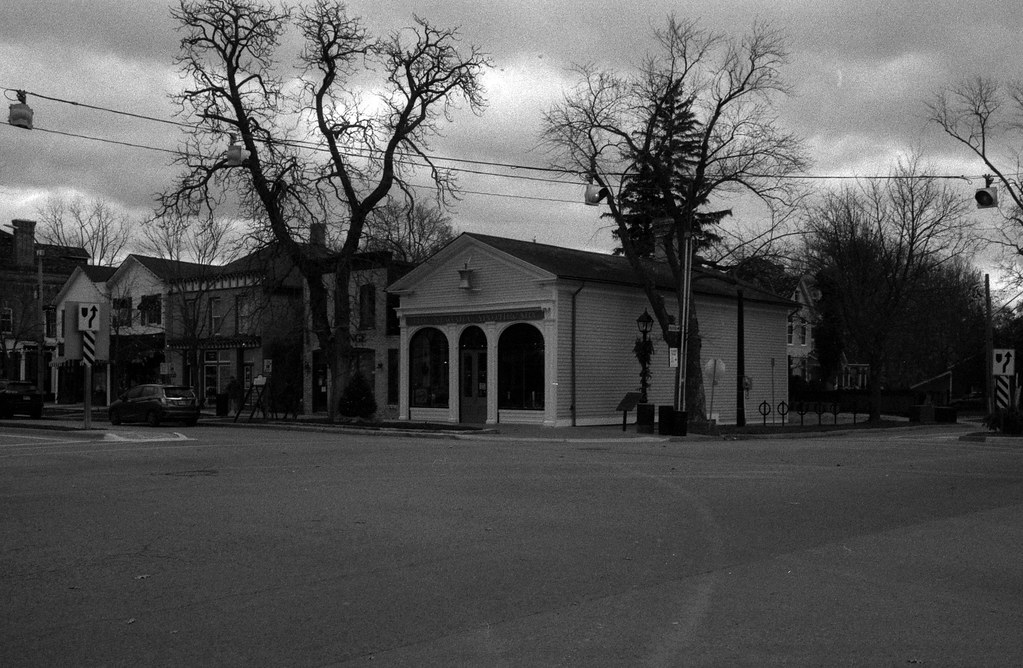
Nikon FM – AI-S Nikkor 35mm 1:2.8 (Yellow-12) – Fomapan 400 @ ASA-400 – Flic Film Black/White & Green (1+49) 13:30 @ 20C
Nikon FM – AI-S Nikkor 35mm 1:2.8 (Yellow-12) – Fomapan 400 @ ASA-400 – Flic Film Black/White & Green (1+49) 13:30 @ 20C
This week I went back to an old favourite lens, the Nikkor 35mm f/2.8. Niagara-On-The-Lake has plenty of space and wide streets that any short of wide-angle lens would prove problematic if I’m trying to focus on a specific building. The 35mm offered a happy medium that a 28mm or a 50mm on either side would be too wide or narrow. I also added a yellow filter to the lens; although I probably could have gone without, I wanted to get a touch more contrast. I shot the Fomapan 400 at the box speed of ASA-400 this week, the reason I tried out a new developer. And I mean, new developer, Flic Film’s Black/White & Green, is a new developer on the market from Canada. Designed as a liquid version of Kodak Xtol, with a viscosity of old school Kodak HC-110 and the same keeping power, the developer did an excellent job with Fomapan 400. While it certainly did an okay job at keeping the less ideal aspects of the film at bay while making the stuff look good.
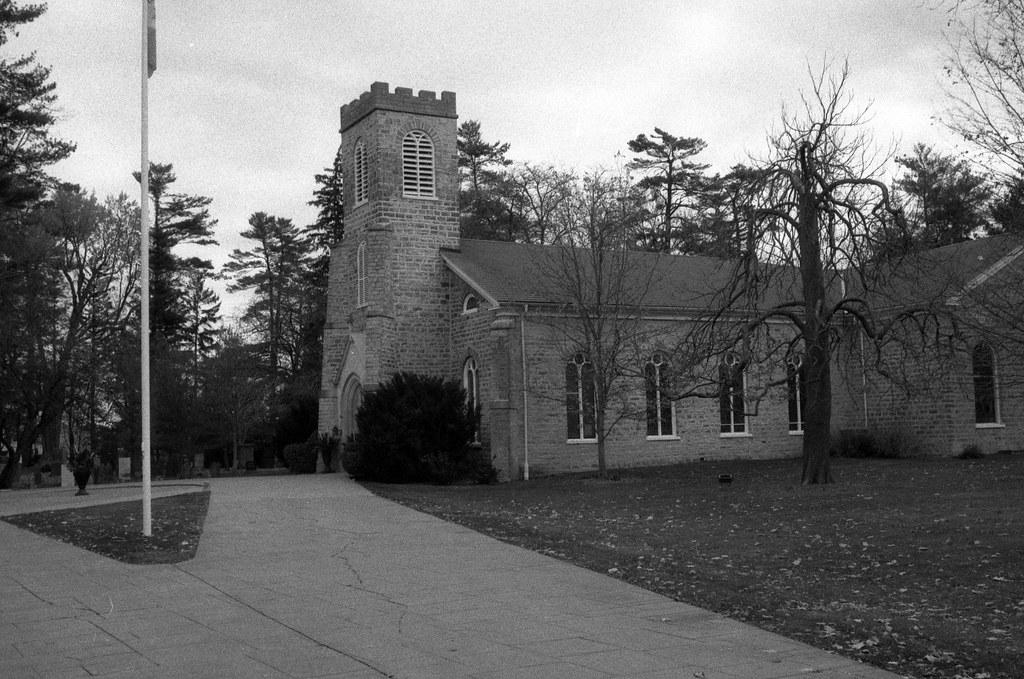
Nikon FM – AI-S Nikkor 35mm 1:2.8 (Yellow-12) – Fomapan 400 @ ASA-400 – Flic Film Black/White & Green (1+49) 13:30 @ 20C
Nikon FM – AI-S Nikkor 35mm 1:2.8 (Yellow-12) – Fomapan 400 @ ASA-400 – Flic Film Black/White & Green (1+49) 13:30 @ 20C
Next week I’m heading back to the Waterloo region to visit another small town that I had a chance to explore last year, the community of New Hamburg!